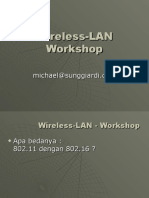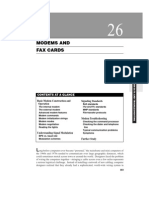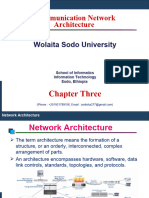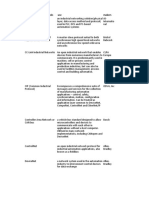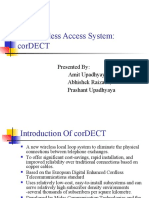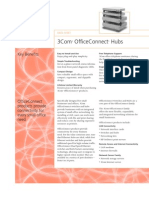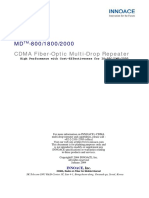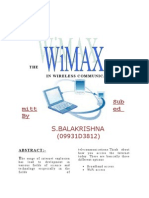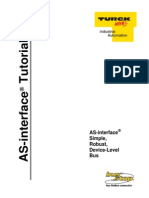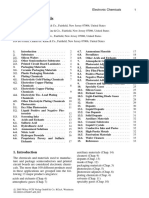Opr0O8L5 Dimension Ing Kapasitansi WiFi
Opr0O8L5 Dimension Ing Kapasitansi WiFi
Uploaded by
vanandreaCopyright:
Available Formats
Opr0O8L5 Dimension Ing Kapasitansi WiFi
Opr0O8L5 Dimension Ing Kapasitansi WiFi
Uploaded by
vanandreaCopyright
Available Formats
Share this document
Did you find this document useful?
Is this content inappropriate?
Copyright:
Available Formats
Opr0O8L5 Dimension Ing Kapasitansi WiFi
Opr0O8L5 Dimension Ing Kapasitansi WiFi
Uploaded by
vanandreaCopyright:
Available Formats
pulse
EDITED BY FRAN GRANVILLE
INNOVATIONS & INNOVATORS
Embedded modem eases Get your wall
data-communications woes power ac/dc
or ac/ac
argeting applications in remote-monitoring systems, point-of-sale terminals, home-secu-
T rity networks, medical devices, and backup-communication systems, Radicom Research
recently announced a low-power, low-cost modem. Standard AT commands control the
Half-Inch Modem, which measures just 1⫻1⫻0.3 in. with a ⫺40 to ⫹85⬚C operating tempera-
The ubiquitous wall wart usually
provides low-voltage, isolated dc
output from the ac mains, but
ture. The modem includes a built-in data pump, modem controller, and onboard international DAA some applications need low-volt-
(data-access arrangement). With power consumption as low as 18 mA in sleep mode, the mo- age ac, either for circuit opera-
dem delivers data rates as high as 56 kbps. Alex Tsau, vice president of operations at Radicom,
tion or because the device it sup-
says, “The Half-Inch Modem simplifies the de-
plies will perform its own local or
sign process for data-communications func-
tions, allowing designers to add connectivity to multivoltage regulation. A new
their applications in a very small space.” series of Class 2 plug-in units
The self-contained modem requires only a from Foster Transformer provides
serial TTL interface and phone-line access to outputs ranging from 9 to 24V
provide data, fax, and voice operation. Handset-
ac, depending on model. The UL-
interrupt and connection-detection features al-
low the modem to share a phone line with oth- listed transformers are rated for
er equipment, eliminating the cost of a dedicat- 10 to 50 VA; prices for a basic
ed line. The Half-Inch Modem is available now, 10-VA model start at $3.10
and prices begin at $21 (1000). (1000).—by Bill Schweber
—by Warren Webb
The new Half-Inch Modem from Radicom 컄Foster Transformer,
Research offers drop-in data communications 컄 Radicom Research Inc, www.radi.com.
www.foster-transformer.com.
for embedded-system designs.
RF connector links boards, uses no cable
Getting dc power or digital signals from one board to an adjacent one is a challenge, but getting
RF signals to make the leap is even more difficult. A compression coaxial connector from Tyco
Electronics can make the task easier. The Blindmate board-to-board connector has one side that
you solder onto the base pc board, and the other side mates by pressing against a tin- or gold-
plated target pad on the adjacent target board, using internal spring pressure. Using the one-
piece connector is far simpler than using cable-based interfaces or two separate board con-
nectors with a spacer wedged between them.
The connector provides a 50⍀ path and operates to 6 GHz with return loss of at least 20 dB
to speeds as high as 2.1 GHz. Tyco offers models for 6.65-, 10-, and 14-mm board spacing, and Making an RF path between par-
allel boards is simpler when you
the connector tolerates both axial (interboard) and radial misalignments: ⫾1 mm for the axial
eliminate a cable assembly and
misalignment for the 10- and 14-mm versions and ⫾0.3 mm for the shortest version. The toler- instead use a spring-loaded com-
ance for radial misalignment is ⫾0.8 mm for all three versions. The Blindmate connector sells pression connector; the Tyco
for $5.80 (10,000).—by Bill Schweber Blindmate operates as fast as 6
컄Tyco Electronics, www.tycoelectronics.com. GHz and comes in three lengths.
OCTOBER 13, 2005 | EDN 23
pulse
Desktop platform
10.13.05
fi.org) interoperability tests for
precertification testing. The bat- Line terminator
supports voice over WiFi tery of tests assures vendors
that their products meet the
says “hasta
zimuth Systems’ two- the past, system faults could Alliance’s standards. Prices for la vista” to
A module W-Series desk-
top WiFi (wireless-fi-
delity)-test platform enables
disable an access point and
compromise an entire wireless
network,” says Cronin. “With
the desktop-engineering sys-
tem range from $40,000 to
$50,000. Software licenses for
reflections
Squeezing an array of
Schottky diodes into a sin-
software designers to test sta- this addition, the testMAC can the voice-over-WiFi- and WiFi- gle package, the QDN001/
tion roaming, performance, isolate problems, analyze their certification enhancements 002/003 series of diode-
function, and range. The system origins, and allow engineers to cost $4500 to $9000. protection networks from
comes in a portable, three-slot correct any anomalies.” —by Dan Strassberg TT Electronics IRC provides
chassis and includes a custom- The company now also offers 컄Azimuth Systems, www. line termination and ESD
built STM-501 module. Ac- a suite of scripts that implement azimuthsystems.com. protection. According to
cording to an Azimuth spokes- the WiFi Alliance’s (www.wi- Debasis Roy, PhD, director
man, the STM-501 is the first of IRC’s Advanced Film
module of its type to provide the Division Thin Film Business
multipurpose-testing capabili- Unit, the devices require no
ties that benchtop-WiFi-test impedance matching, be-
systems require. The W-Series cause they terminate load
software now provides en- impedances and clamp
hanced support for voice over high- and low-state reflec-
WiFi, including voice-quality tions and noise. The termi-
measurements to ensure clear nators target use with high-
and repeatable voice transmis- speed data lines, especially
sions and a full software-test PCI and SDRAM buses,
suite for comprehensive WiFi- and reduce overshoot and
phone analysis. “By adding the undershoot with near-zero
voice-over-WiFi tests, Azimuth power dissipation.
has become the first—and, cur- The QDN001 includes
rently, the only—company to of- 36 diodes featuring clamp-
fer fully automated testing of ing current of ⫾50 mA, op-
WiFi phones’ roaming parame- erating voltage of ⫺0.3 to
The W-Series modular desktop WiFi-test system is the first to of-
ters,” says Ray Cronin, the com- ⫹7V, and diode forward-
fer fully automated testing of WiFi phones’ roaming parameters.
pany’s chief executive officer. voltage drop of 0.5V at 10
In addition, the company has mA to 0.8V at 50 mA. The
added programmable exten- FEEDBACK LOOP QDN002 series incorpo-
sions to its testMAC (media- “I theorize that overly high prices rates 17 diodes for ESD
access-control) layer. These protection, with a 15-kV hu-
extensions permit packet-by-
encourage pirating. Send a mes- man-body-model rating and
packet traffic generation and sage to the manufacturers and ven- 8-kV ESD contact protec-
analysis, allowing vendors to dors by not buying their products.” tion; the QDN003 has 18
stress-test their client-to-ac- Joseph Travis, in EDN’s Feedback Loop at www.edn.com/ Schottky diodes and similar
cess-point communication. “In article/CA633438. Add your comments. ratings.—by Bill Schweber
왘TT Electronics IRC,
DILBERT By Scott Adams www.irctt.com.
The QDN00x series of ter-
minators clamps high-
speed reflections, under-
shoots, and overshoots and
protects against ESD.
24 EDN | OCTOBER 13, 2005
pulse
Processor integrates
10.13.05
more peripheral support EPIC computer pushes
tmel’s AT91SAM7X128 tion engine, with the peripher- temperature extremes
A and AT91SAM7X256
ARM7-based, flash mi-
crocontrollers include periph-
al DMA controller, can encrypt
or decrypt data at a rate of 80
Mbps for AES, 32.8 Mbps for
With potential application in medical devices, security
equipment, industrial machinery, aerospace projects,
and transportation systems, VersaLogic’s latest EPIC
eral support for 10/100 DES, and 20 Mbps for 3DES. (embedded-platform-for-industrial-computing)-format
Ethernet; CANs (controller- Software-development sup- single-board computer operates at ⫺40 to ⫹85⬚⬚C. The
area networks); full-speed, 12- port includes compilers, linkers, company based the Gecko design on the newer AMD
Mbps USB 2.0 devices; and and debuggers from IAR Sys- GX-500 processor, which offers 500-MHz-equivalent
high-speed AES/3DES (Ad- tems (www.iar.com), Green Hills performance and draws only about 1.5W. The low pow-
vanced Encryption Standard/ Software (www.ghs.com), and er consumption results in minimal heat dissipation,
Triple Data Encryption Stan- Keil Software (www.keil.com). eliminating the use of an onboard fan.
dard) encryption in a single de- CMX Systems (www.cmx.com), The module features as much as 512 Mbytes of DDR
vice. The 50-MIPS microcon- Micrium (www.micrium.com), RAM, integrated video with analog and LVDS flat-panel
trollers offer either 32 or 64 and FreeRTOS (www.freertos. outputs, a stereo-I/O line, 10/100-Mbps Ethernet, ana-
kbytes of SRAM, along with com) offer RTOSs for the log and digital I/O, four USB ports, four communica-
128 or 256 kbytes of 25-nsec SAM7X processors. TCP/IP tions ports, LPT and IDE (integrated-development-envi-
flash memory that supports stacks that are available now ronment) interfaces, and a CompactFlash socket. The
deterministic memory access. include open-source uIP/lwIP, PC/104-Plus site accommodates both PC/104 and
A peripheral DMA controller Micrium’s royalty-free C/ PC/104-Plus modules for system expansion. The Gecko
connects each peripheral di- TCP-IP, and CMX Systems’ roy- includes safety features, such as transient-voltage-sup-
rectly to on-chip memory, en- alty-free MicroNet. The AT- pression devices for
abling high-throughput data 91SAM7X128 is available now ESD protection, self-re-
transfers without any proces- in a green, 100-lead LQFP for setting fuses for user
sor overhead. Additional pe- $7.20 (10,000); the AT91- I/O, and a watchdog
ripherals include a 10-bit ADC, SAM7X256 is available in a timer for hardware-lev-
an eight-level priority-interrupt green, 100-lead LQFP for el application control.
controller, an SPI, an SSC $8.65 (10,000). The AT91- Prices start at $673
(synchronous serial controller), SAM7X-EK evaluation kit is The new Gecko single-board (OEM quantities).
a TWI (two-way interface), available from Atmel for computer in the EPIC form fac- —by Warren Webb
UARTs, and supervisory func- $250.—by Robert Cravotta tor fits space-constrained appli- 왘VersaLogic Corp,
tions. The embedded encryp- 컄Atmel, www.atmel.com. cations with restricted cooling. www.versalogic.com.
FAST CRYSTAL RC
SCALABLE OSCILLATOR OSCILLATOR
FLOATING-
ADSL
POINT
MODEM WATCHDOG AES
INTERFACE PLL
TIMER
EMBEDDED
ICE
REAL-TIME 3DES
POWER-ON TIMER
RESET 32-BIT, PMC
128- TO 256-kBYTE PROGRAMMABLE-
AIC
BROWN- FLASH INTERVAL TIMER
OUT ARM7TDMI
MEMORY
DETECTION CORE
CONTROLLER THREE
PERIPHERAL TIMERS
32-BIT,
32- TO 64-kBYTE DMA CONTROLLER
1.8V FOUR
SRAM
LOW- PWMs
DROPOUT
AMPLIFIER PIO
ASB
10-BIT,
AMBA BRIDGE
EIGHT-
APB CHANNEL
ADC
USB SYNCHRONOUS 10/100-MBPS
SPI SPI TWO-WAY DEBUGGING USART USART SERIAL CAN ETHERNET
INTERFACE UART DEVICE
CONTROLLER MAC
The AT91SAM7X provides an extended peripheral set that supports the ARM7 processor core.
26 EDN | OCTOBER 13, 2005
pulse
10.13.05
microsoft.com) project-man-
agement tool, the two have SMT plasma
Package provides IDE little in common. Although it arrester features
for heterogeneous can show you whether anoth-
er developer is modifying a
low, stable
distributed systems software module that you wish capacitance
to use, LabView Project pro- A trio of Greentube gas-
ccording to John Pas- that constitute major improve- vides no configuration-control
A
plasma arresters (similar to
quarette, National In- ments over their counterparts functions. It does, however, gas-discharge tubes) from
struments’ director of in earlier releases. work with most popular con- Littelfuse targets use as
software marketing, LabView LabView 8 includes exten- figuration-control packages. surge protection for broad-
8, the latest release of Lab- sive capabilities for locating NI offers LabView 8 in a band circuits. The devices
View, is the most extensive re- hardware and software re- low-cost student version; have maximum capacitance
vision yet. NI developers have sources that you may want to prices for base, full, and pro- of just 1.5 pF, along with
been working since 1998 on incorporate into an applica- fessional versions start at low insertion loss, and these
some of the new features. The tion. Examples are networked $995. Add-on components in- values remain constant over
company’s goal for the product instruments and driver-soft- clude a PDA module, which a range of voltages and
is to provide an IDE (integrat- ware modules that reside on costs $995, and FPGA, real- temperatures, a critical
ed development environment) networked computers. Lab- time, and data-logging/super- factor for gigahertz-range
for heterogeneous distributed View Project searches the visory-control modules, each applications.
systems for design, design network for these modules, of which costs $1995. The SL0902 devices,
verification, test, automation, allows you to select them for —by Dan Strassberg with a 5⫻5-mm footprint,
and control. Such systems can use in your project, and 컄National Instruments, are available in 90, 230,
take many forms, some of tracks the availability of re- www.ni.com/labview, ftp:// and 350V versions. The
which incorporate subsystems sources that you share with ftp.ni.com/pub/newsimages/ protectors generally work in
of multiple types, including another developer or project. Constellation/LabView_8_% conjunction with a fuse to
conventional PCs; intelligent Whereas the term “LabView 20Distributed_White_Paper. provide both surge and fus-
modular instruments, such as Project” may make you think of pdf. ing protection in applica-
PXI (PCI extensions for instru- the Microsoft Project (www. tions such as telephone-
mentation); distributed I/O, company and DSL lines,
such as NI’s Compact satellite boxes, and CATV
FieldPoint and Compact RIO interfaces. Their impulse
(reconfigurable I/O); PDAs; discharge-current rating,
and custom-designed system per industry-standard test
components based on FPGAs. conditions, shows that they
Like earlier versions of can divert a 2.5-kA pulse
LabView, this release supports without destruction.
hardware from a broad spec- The 90V version has a dc
trum of manufacturers, includ- break-over rating of 72 to
ing NI’s competitors. 108V at 2 kV/sec with a
To bring the many disparate maximum break-over volt-
elements under the LabView LabView 8 includes LabView Project, whose Explorer window age of 400V at 100V/
umbrella, the new release fo- (center left) displays the status of hardware and software sec and 600V at 1 kV/
cuses on its ability to measure resources that your project can use. sec. The 230 and 350V
within minutes after installa- units have dc break-over
tion, thanks to newly enhanced FEEDBACK LOOP ratings of 184 to 276V and
LabView Express features; 400 to 500V, respectively;
streamlining application and “That’s what makes Design Ideas maximum break-over volt-
device management by means so useful; they are starting points ages differ somewhat. All
of the LabView Project soft- models have an ac discharge
for a design or useful concept that
ware module; and designing, current of 2.5A. The SL0902
distributing, and synchronizing
can be molded into an individual devices sell for less than 20
intelligent devices and sys- solution for a particular design.” cents (OEM quantities).
tems. At the heart of these Steve Hageman, in EDN’s Feedback Loop at www.edn.com/ —by Bill Schweber
functions are features either article/CA379888. Add your comments. 왘Littelfuse Inc, www.
that are new to this release or littelfuse.com.
28 EDN | OCTOBER 13, 2005
pulse
R E S E A R C H U P DA T E
BY BILL SCHWEBER
10.13.05
Coating may dispel GaN FET produces
condensation fog 174W at 6 GHz
Researchers at the Massachusetts Institute of Technology have For satellite and cellular base sta-
developed a coating, made from layers of silica nanoparticles tions, a GaN (gallium-nitride) pow-
and a special polymer, which may counter droplet accumulation er FET from Toshiba Corp surpass-
on windows, goggles, and lenses. Normally, condensed droplets es the output of GaAs (gallium-ar-
scatter light in random patterns, which makes the material senide) devices, improving power
translucent and foggy. The density by a factor of eight. Currently available GaAs
coating is superhydrophilic (wa- devices are rated at about 90W/6 GHz and 30W/14
ter-loving) and attracts the wa- GHz, but GaN has higher saturation electron velocity,
ter droplets; in turn, the drop- dielectric breakdown voltage, and operating-tempera-
lets flatten and merge into a ture range than GaAs. These factors are important for
uniform, transparent film or achieving higher power gigahertz-range operation.
sheet on top of the underlying The device uses an epitaxial-layer structure, with op-
surface. timized FET layout and dimensioning, plus a new sur-
The photo shows how re- face-treatment process for low contact resistance and
searchers coated one glass low gate-leakage current. Toshiba’s production also
slide (left) with antifogging coating and left the other one un- requires a modified version of the conventional step-
coated (right). They then placed the glass slides in a freezer, per process, which is better for mass-production than
brought them out into humid air, and positioned them over a the electron-beam lithography process that C-band
photo. To learn more, go to http://web.mit.edu/newsoffice/ GaN devices commonly use. A GaN power-FET chip
2005/fog.html. measures 2.92⫻ ⫻0.71 mm, and the outer cavity of a
컄Massachusetts Institute of Technology, www.mit.edu. packaged device with four chips, such as the one in
the photo, measures 24.5⫻ ⫻17.4 mm. For more, go to
www.toshiba.co.jp/about/press/2005_09/pr1201.htm.
Microstrip line uses layered dielectrics 왘Toshiba Corp, www.toshiba.co.jp.
for front-side antenna patch
By using multiple layers of di- Designers can use the pc-
Fuel cell beats
electric material on a pc board, board area under the ground power-density benchmarks
engineers at NASA’s Jet Pro- plane for conventional circuit- UltraCell Corp claims that its cells, using a reformed-methanol
pulsion Laboratory have de- ry. Because there is no feed technology, provide significantly more power density than the
veloped a microstrip-line patch circuitry behind the ground conventional “direct-methanol” approach and twice the power
antenna that mounts on the plane, the patch antenna density of lithium batteries. Key to the improvement is a mi-
front of a pc board and is easy needs no through hole in the croreformer, which the company says generates fuel-cell-ready
to electrically couple to the ground plane, minimizing RF hydrogen from a highly concentrated methanol solution. The ap-
electronics. The thin, inexpen- leakage. For more, go to the proach requires no water reservoir, cleanup, distinct internal re-
sive design uses a ground September 2005 issue of former, or water-management system. UltraCell has shipped 32-
plane on the underside of the Tech Briefs at www.techbriefs. oz prototypes to the military. Those devices deliver 45W contin-
high-permittivity pc-board sub- com. uous power and 20W average output over 24 hours. For more,
strate and a low-permittivity- 컄National Aeronautics got to www.ultracellpower.com.
dielectric spacer layer on the and Space Administration ULTRACELL RMFC
0.6 TO 0.7V/CELL
top side; the microstrip patch Jet Propulsion Laboratory, 60 TO 70% H2
CO2
(HIGH-EFFICIENCY,
METHANOL SMALLER STACK)
radiator caps all sides. www.jpl.nasa.gov. 0.6 TO 0.7V
FUEL PROCESSOR FUEL 0.6 TO 0.7V
CARTRIDGE CELL
0.6 TO 0.7V
MICROSTRIP WIRE
MICROSTRIP PATCH CONNECTION 0.4V/CELL
TRANSMISSION RADIATOR FROM FEED LINE (LOW-EFFICIENCY,
(FEED LINE) TO PATCH DMFC LARGER STACK)
AS MUCH
MIXER 3% 0.4V
LOW- AS 100% 0.4V
METHANOL FUEL
FUEL METHANOL 0.4V
PERMITTIVITY HIGH- CELL 0.4V
DIELECTRIC CARTRIDGE
PERMITTIVITY 0.4V
SPACER DIELECTRIC
LAYER PC-BOARD
WATER
SUBSTRATE RESERVOIR
GROUND PLANE SIDE VIEW WATER-
MANAGEMENT
SYSTEM
30 EDN | OCTOBER 13, 2005
pulse
GLOBAL DESIGNER Infineon’s new, low-cost E-
Goldradio handset combines
the baseband processor and
Low-cost handsets gain the RF transceiver in a 9⫻9-
mm-footprint chip.
traction in India “A lower risk approach is to
urgeoning demand simplify the development of the combine functions into a sys-
B from mobile-service op-
erators for ultralow-
cost handsets to service price-
final handset product.
“In phone design, there are a
few major building blocks—
tem-in-package design, which
saves board area and manufac-
turing cost but retains the per-
sensitive emerging markets, among them: digital baseband, formance of the radio and min-
such as India, is motivating analog baseband, RF section, imizes risk because vendors can
semiconductor vendors to de- and memory, which comprise easily port software to such a
velop single-chip-handset of- the bulk of the cost drivers for device,” says Grant.
ferings. For example, Texas these handsets,” explains Har- Infineon’s new, low-cost E-
Instruments recently demon- ish M, general manager of Goldradio handset combines
strated the first less-than-$40 business development at TI the baseband processor and
handsets built in India from India. An ultralow-cost handset the RF transceiver in a 9⫻9-
concept to design to produc- should have no more than 100 mm-footprint chip. It enables
tion. BPL Ltd (www.bplmobile. components, compared with manufacturers to implement
com) and Quasar Innovations 600 or more for a high-end the baseband and RF func- board technology and single-
(www.quasarinnovations.com) feature phone or smart phone. tions on less than 4 cm2 of side mounting, further reducing
based the Primus GSM phones Grant says that manufactur- board space—about 30% less manufacturing costs. TI also
that they developed on TI’s TCS ers can reduce BOM (bill-of- than two-chip offerings require. offers the similar single-chip
chip set. These handsets incor- materials) costs by integrating It also cuts the BOM cost by DRP (digital-radio processor).
porate only basic voice and core handset functions, such as about 30% by eliminating ex- —by Chitra Giridhar,
short-message service—no cam- digital and analog processing, ternal components, including EDN Asia
eras, color screens, or MP3 play- power management, and a radio capacitors and discrete com- 컄Analog Devices, www.
ers, instead emphasizing low transceiver, into one chip. But ponents, that a two-chip ap- analog.com.
cost and an intuitive user inter- this approach is risky, because it proach requires. And a low- 컄Infineon, www.infineon.
face. requires a high-performance component-count design and com.
“We expect the industry will wafer process, and may be un- simplified layout enable the 컄Texas Instruments, www.
be selling an ultralow-cost mo- suited for consistent production. use of cheap, four-layer pc- ti.com.
bile phone for less than $20 by
10.13.05
the start of 2006. These costs
include electronic components, Japanese-automotive software goes horizontal
connectors, the pc board, the Toyota Motors is moving to a horizontal and cooperative model for software development
casing with display and keypad, to meet the increasing demand for more sophisticated and widespread automotive elec-
software, and the battery,” says tronics. Traditionally, Japanese designers in the automotive industry have developed soft-
Horst Patch, vice president of ware for single applications instead of using standardized software platforms upon which
the Communication Business vendors could build myriad applications, according to Koichi Tanigawa, general manager of
Group at Infineon Technologies. the development department at the integrated-system-engineering division of the vehicle-
Ultralow-cost handsets will engineering group of Toyota. He recently spoke at the Freescale (www.freescale.com)
enable telephony in parts of the Technology Forum Japan 2005 in Tokyo.
world in which land-line service With the increased use of microcontrollers and sensors in such automotive applications
is unavailable or unreliable, says as vehicle control, safety, and pollution control, automotive electronics have become hot
Douglas Grant, business-devel- markets. Fulfilling the needs of those applications requires a lot more software develop-
opment manager with Analog ment, he says.
Devices’ RF and Wireless Sys- In the Japanese-automotive industry, suppliers and automotive manufacturers have a
tems Group. Grant adds that vertical-integration relationship, in which conventional and limited suppliers deliver compo-
chip-set suppliers pursuing the nents to automotive manufacturers. This approach makes suppliers a type of subsidiary of
ultralow-cost-handset market the automakers in vertical-integration systems. For example, Toyota has developed its own
need to provide robust refer- dedicated software. But, as the amount of the software increases, it is using multiple de-
ence platforms and even com- velopers to develop individual layers, including the operating system, middleware, and ap-
plete turnkey designs with pre- plications.—by Takatsuna Mamoto, EDN Japan
loaded software features to 왘Toyota Motor Corp, www.toyota.com/jp.
32 EDN | OCTOBER 13, 2005
pulse
EDITED BY FRAN GRANVILLE AND ANGELA GOSMANN
INNOVATIONS & INNOVATORS
Spectrum analysis at 42.98 GHz
gilent has extended the coverage of its PSA series of
A spectrum analysers with the E4447A model that now
reaches to 42.98 GHz. The company expects the extend-
ed performance to be used by developers of 3G cellular and oth-
er wireless and digital radio systems, as well as by microwave
and millimeter-wave engineers. The instrument offers ⫾0.62 dB
(⫾0.17 dB typical) amplitude accuracy at 1 GHz; fast measure-
ment of adjacent channel power, with low-level spur search across
the whole frequency span. A 2-dB step attenuator covers the range
up to 42.98 GHz. The PSA also performs conducted and radiated
CISPR and MIL-STD EMI measurements. A Power Suite tool set
offers 10, one-button RF and microwave power measurements, in-
WCDMA and microwave designers are among those who can
examine signal artefacts up to 42.98 GHz. cluding multi-carrier ACP, CCDF and TOI. Fifteen optional meas-
urement personalities perform complex measurements such as
phase noise for oscillators, the noise figure of an amplifier, scalar network analysis for components, as well as digital modulation
analysis on 2G to 3.5G signals.
Users can combine the PSA hardware with the 89601A VSA software, to add I/Q analysis up to 8 MHz, analogue and digital
demodulators, and time, frequency and modulation analysis tools, with standard-signal presets that include GSM (EDGE), cdma2000,
WCDMA, and 1⫻EV-DO.—by Graham Prophet
컄Agilent, www.agilent.com
Silicon-on-sapphire hosts superior switches
eregrine Semiconductor builds RF CMOS chips using a a drop-in replacement for the company’s 4263 6-throw antenna
P process it calls UltraCMOS: it builds CMOS circuitry in epi-
taxial layers on a sapphire substrate. Freed from the para-
sitic capacitances that are inherent in devices built on a bulk
switch, delivered in a flip-chip package for incorporation into RF
handset modules. Peregrine’s VP of Marketing Rodd Novak
notes that 3G RF-front-ends present GSM-level technology with
silicon (semiconducting) substrate, UltraCMOS overcomes limita- challenges in terms of linearity and IM3—a GSM phone operat-
tions in device operating frequency, non-linearities in RF behaviour, ing in close proximity to a 3G handset could potentially cause a
RF isolation, power loss and limited-Q resonant structures. Building blocking signal in the WCDMA receive band, due to the inter-
CMOS on a non-conducting sapphire substrate also allows modulation product, in the receive chain, of the two transmitter
Peregrine to construct mixed-signal circuitry with significant signals. The PE42660 will provide sufficient linearity through the
amounts of control logic. The company’s process further allows the antenna switch path to eliminate this possibility, Novak says. Its
company to integrate EEPROM with no additional mask steps. IM3 performance is 25 dB better than its predecessor and meets
In its latest products, Peregrine has implemented an upgrade the 3GPP specification at all phase angles (between switch and
it calls HaRP, (for “harmonic performance”). Further parasitic ca- duplexer), being under ⫺110 dB for a transmit power level of
pacitances have been eliminated in device layouts—although 20 dBm. Third-harmonic figures are 20 dB better than before,
the fundamental technology remains the same—to produce im- measured with 32 dBm switched to a 50-⍀ antenna load.
provements in second and (especially) third-harmonic distortion, Other devices recently introduced in UltraCMOS include
and in third-order intermodulation (IM3) performance. One of the radiation-hard parts for military/satellite use; a 13-GHz pre-
first products to exploit the capability is an antenna switch de- scaler, and a 6-bit digital attenuator.—by Graham Prophet
signed for 3G cellphone handsets. The 42660 is a derivative and 컄Peregrine Semiconductor, www.psemi.com
pulse
Tough touch screens need
no seals
f you have not been involved sides of a capacitor plate for
I with their design, you might
assume that the technology
of touch screens is mature and
multiple keypad sensing pat-
terns relatively easily in PCB,
where they can design with
robust, and that you can read- double-side boards or jumper
ily specify screens that offer connections. Transparent ITO
accurate sensing of a fingertip, layers present more of a chal-
with good transparency, and lenge in routing all the con-
that are robust and cost-effec- nections, in a single layer, to
tive. According to touch- multiple keypad patterns. More
sensor IC-supplier Quantum complex still is the problem of
Research Group, that combi- addressing a grid of capacitor With its new touch-screen chips, Quantum can enable products such
nation of features is in fact sense plates to make an X-Y as this concept for a hand-held control unit to be extremely robust.
very difficult to achieve—a sit- position sensor array.
uation the company aims to Mass-market touch screens would be to place the sensing edge-addressable, ITO pattern
rectify with a new series of ICs frequently employ resistive array behind the front panel, to form two capacitor plates
and reference designs. technologies, where a finger which they can then make on an X-Y grid that can be up
Quantum designs chips for touch compresses a gap—nor- continuous, with no need for to 10 cm across. It also proj-
touch sensing using a ca- mally separated by spacers seals or bezels. When they use ects the capacitor’s electric
pacitive technology it terms forming a tiny air gap—between capacitive techniques on the field pattern through the di-
“charge transfer”. The tech- two resistor-pattern layers. reverse face of display panels, electric so that its field lines
nique requires no electrical This, Quantum says, carries they encounter the added project into the detection
connection between an acti- disadvantages such as the complications of a reduced space with the necessary
vating finger touch and the de- need to place the sensing el- field disturbance, due to the shape.
tection circuitry—as with other ement on the “public” face of greater distance and thickness Using the chips, you will be
capacitive methods, the pres- the screen, making it vulnera- of dielectric mat between fin- able to build extremely robust
ence of a finger alters the cir- ble to damage; and calling for ger and sensor. Also, the signal front panels with (for example)
cuit capacitance between two a bezel and seal around the detected from a finger is less LCD screens behind them,
plates. Quantum’s approach is edge of the sensing area. It distinguishable from that of that will offer 90% light trans-
to sense the level shift in a can, however, readily provide the hand to which that finger mission. On the surface you
pulsed signal through the ca- individual keypad sites or X-Y is attached. These problems can define—with software in-
pacitor—its chip design digitis- position sensing. manifest themselves as sig- terpreting the reported posi-
es the signals, makes compar- Capacitive techniques can nal/noise issues, and prob- tion and direction of a finger
isons in the digital domain, address these issues—at the lems of determining the exact touch—buttons, touch wheels,
and stores reference levels in cost of complexity and a cer- location of the touch. sliders and 2D track-pads.
on-chip EEPROM to guard tain amount of loss of trans- Today, Quantum is to intro- Removing the need for seals
against phenomena such as parency—using a two-layer duce a series of chips (the and bezels will suit the tech-
long-term drift and component structure with one set of plates company supplies chips, not nique to medical and industri-
aging. This, the company says, printed on each of two ITO complete modules) that it says al environments. Response
is an important differentiator layers. Quantum addresses will solve all of these problems. time is 20 msec, and for bat-
against other sensing tech- the robustness problem in one They will operate with a single tery operation, standby power
niques, such as oscillator fre- of its technology solutions by layer ITO pattern printed on the demand is 30 A. Quantum
quency-shift. printing the ITO on the reverse reverse side of a transparent says that a 10-cm diagonal
In opaque sensors, the ca- of a PET (poly-ethylene- fascia up to 3 mm thick, pro- ITO film should cost around
pacitor plates can be printed- terephthalate) layer that can viding good signal/noise ration $1.50, making for a $3.00
circuit patterns on low-cost then be bonded to the screen. and detecting finger touch overall BOM cost, the chips
PCB, hidden behind a front PET (the soda-bottle plastic) is with a resolution of 256⫻256 selling for around $1.50
panel; in touch-screen applica- a very tough material that points. Making this possible (100,000).
tions, the plates are printed stands up to heavy usage. is a labyrinth pattern that —by Graham Prophet
patterns of (transparent) indi- However, designers still need Quantum’s researcher Luben 컄Quantum Research
um-tin-oxide. Designers can to seal the sensing area on the Hristov devised. The new Group, ⫹44 2380 565600,
route connections to both front panel. An ideal solution geometry allows a single-layer, www.qprox.com
pulse
Synthesiser chip challenges
HF-crystal oscillators
n its mixed-signal chips, Silicon digitally rather than by “pulling”,
I Laboratories employs a frequen-
cy-synthesis technique for clock
generation that it calls DSPLL: now,
yielding better stability and much-im-
proved linearity (better than ⫾1%).
Also contributing is internal regula-
it is launching a range of frequency- tion of the supply voltage rails.
source parts that embody that tech- Operation is up to from 10 MHz to
nology to perform the same function 1.4 GHz (square wave, 50% duty-
as standard crystal oscillators and cycle output) with jitter of under
voltage-controlled crystal oscillators. 0.3 psec rms, and the resolution—
The Si 5390 and 550 are frequency- according to Silicon Labs’ Director
synthesis chips that the company Mike Petrowski—is in excess of
will pre-programme to produce up to 40 bits, or under 1 part-per-billion.
four output frequencies (selectable) If frequency is fully selectable
from a base frequency that a low- digitally, why not give the user con-
cost, standard, fundamental crystal trol of that frequency-selection
generates. process? Petrowski noted that the
Silicon Labs has created the prod- company has tailored this part to
uct to exactly match today’s market match the existing market model for
for XOs and VCXOs; if you have a XO supply and declined to comment
need for a high-stability source of a on where such a user-settable chip
specific frequency, you can place an might appear in the future. Likewise,
order with a crystal oscillator manu- he acknowledged that there is no
facturer, and in due time they cut the impediment to extending the tech-
required crystal element and ship nique to other environments where
your oscillator. The 530/500 parts designers need crystal stability in
aim to mimic that process but on top frequency sources, such as oven-
of that cut delivery time to days, stabilised circuits. Depending on
and improve on most of the existing features selected, the chips—which
oscillator specifications such as sta- are delivered as a single package
bility and reliability. The chip employs containing IC and reference crystal—
DSP techniques together with a very- sell for $6.05 to $88.95 (1000).
low-jitter voltage-controlled oscillator. —by Graham Prophet
The chip produces VCO operation 컄Silicon Labs, www.silabs.com
The model 530 and 550 chips are presented as packaged oscillators in a sealed
module that co-mounts the silicon and the reference crystal.
You might also like
- The RF Reader ADIDocument88 pagesThe RF Reader ADIyuri_bvNo ratings yet
- Wireless LAN MichaelDocument28 pagesWireless LAN MichaelMuhammad Fahmi Mubarok NahdliNo ratings yet
- Wireless LAN MichaelDocument28 pagesWireless LAN MichaelYoga PratamaNo ratings yet
- Whatdev PDFDocument2 pagesWhatdev PDFIgidio PedroNo ratings yet
- Modems and Fax CardsDocument55 pagesModems and Fax CardsDrift GeeNo ratings yet
- Ethernet Industrial - Explicativo de Phoenix ContactDocument48 pagesEthernet Industrial - Explicativo de Phoenix Contactluk@_sNo ratings yet
- CN LAB MANUAL PracticalDocument79 pagesCN LAB MANUAL PracticalMAYANK GUPTANo ratings yet
- Full-Wave, TwinAx, Differential Cable Modeling 2008Document6 pagesFull-Wave, TwinAx, Differential Cable Modeling 2008john BronsonNo ratings yet
- 2K9M1 - 210-217 Ethernet SwitchesDocument8 pages2K9M1 - 210-217 Ethernet SwitchesSunil KumarNo ratings yet
- Networking Chap3 - 220121001827Document48 pagesNetworking Chap3 - 220121001827zerihun nanaNo ratings yet
- Wired Equivalent Privacy Algorithm: 10CE100 Wireless LANDocument16 pagesWired Equivalent Privacy Algorithm: 10CE100 Wireless LANJanki ShahNo ratings yet
- Sensor Networks v4Document15 pagesSensor Networks v4Marcus LittlewoodNo ratings yet
- Embedded Communications: Version 2 EE IIT, Kharagpur 1Document15 pagesEmbedded Communications: Version 2 EE IIT, Kharagpur 1ahamed100% (1)
- Spra 139Document16 pagesSpra 139tedNo ratings yet
- Industrial Automation Communication ProtocolsDocument7 pagesIndustrial Automation Communication ProtocolsNeshvar DmitriNo ratings yet
- Power-over-LAN Midspans and Active Splitter: White PaperDocument10 pagesPower-over-LAN Midspans and Active Splitter: White PaperHersson ArevaloNo ratings yet
- Analog Front End For 3G Femto Base Stations Brings Wireless Connectivity HomeDocument5 pagesAnalog Front End For 3G Femto Base Stations Brings Wireless Connectivity Homeas147No ratings yet
- Network GlossaryDocument8 pagesNetwork Glossarysandeep kumarNo ratings yet
- Unit 3 - InpDocument20 pagesUnit 3 - Inpniya enzieNo ratings yet
- Chapter 3Document48 pagesChapter 3anebek555No ratings yet
- 1897 N TRON Designing A Reliable Industrial Ethernet Network White PaperDocument14 pages1897 N TRON Designing A Reliable Industrial Ethernet Network White PaperfellskevNo ratings yet
- DeltaV CHARMDocument37 pagesDeltaV CHARMThiago Fernandes0% (1)
- A Paper Presentation On: The Dawn of New Technical EraDocument17 pagesA Paper Presentation On: The Dawn of New Technical Erajyothsnas28No ratings yet
- MOTOMESH Solo - Spec Sheet - 9.21.08 PDFDocument2 pagesMOTOMESH Solo - Spec Sheet - 9.21.08 PDFLiliana OrozcoNo ratings yet
- RF Over Ethernet For Wireless Infrastructure Gerald Britton, Byron Kubert, and John ChapinDocument5 pagesRF Over Ethernet For Wireless Infrastructure Gerald Britton, Byron Kubert, and John ChapinSeema ChauhanNo ratings yet
- SW500Document26 pagesSW500Cocis PeTrisorNo ratings yet
- CA Ex S1M10 Planning and Cabling NetworkDocument53 pagesCA Ex S1M10 Planning and Cabling Networkhttp://heiserz.com/No ratings yet
- Tait DS TAIT-AXIOM-MobileDocument4 pagesTait DS TAIT-AXIOM-MobileForoughNo ratings yet
- Cvm-E3-Mini-Wieth: Power Analyzer With Wi-Fi and Ethernet CommunicationsDocument8 pagesCvm-E3-Mini-Wieth: Power Analyzer With Wi-Fi and Ethernet CommunicationsDavid SilvestreNo ratings yet
- 2005 DeviceNet Quick Start FinalDocument7 pages2005 DeviceNet Quick Start FinalSolange Antonio CarlosNo ratings yet
- Computer NetworksDocument10 pagesComputer NetworksThe GodfatherNo ratings yet
- Wireless Lan: Presented byDocument65 pagesWireless Lan: Presented bysathya_mca17100% (1)
- The Wireless Access SystemDocument18 pagesThe Wireless Access Systemdjayaswal312No ratings yet
- VTC07 GlennDocument6 pagesVTC07 Glennhassan abousalehNo ratings yet
- Winllink1000 SeriesDocument4 pagesWinllink1000 SeriesCesar Rocha - GMAILNo ratings yet
- explorer-323-productsheet-a03-hiDocument2 pagesexplorer-323-productsheet-a03-hirom clownNo ratings yet
- A Brief Introduction To Controller Area Network PDFDocument6 pagesA Brief Introduction To Controller Area Network PDFSiva100% (1)
- A Brief Introduction To Controller Area Network PDFDocument6 pagesA Brief Introduction To Controller Area Network PDFSivaNo ratings yet
- Q SERIES Control Network ModulesDocument12 pagesQ SERIES Control Network ModulesSergio Alejandro MartinezNo ratings yet
- 3com Officeconnect Hubs: Key BenefitsDocument4 pages3com Officeconnect Hubs: Key BenefitsewrategqgerNo ratings yet
- CDMA Fiber-Optic Multi-Drop Repeater: High Performance With Cost-Effectiveness For IS-95C/IMT-2000Document6 pagesCDMA Fiber-Optic Multi-Drop Repeater: High Performance With Cost-Effectiveness For IS-95C/IMT-2000PuujeeNo ratings yet
- Pmma 3Document8 pagesPmma 3MancamiaicuruNo ratings yet
- Sub Mitt Ed By: S.BalakrishnaDocument11 pagesSub Mitt Ed By: S.BalakrishnaBalakrishna SambariNo ratings yet
- Chapter 1Document25 pagesChapter 1jasminesherwinpreamNo ratings yet
- User ManualDocument43 pagesUser ManualCarlos Andrés Vargas CalderónNo ratings yet
- As I TutorialDocument20 pagesAs I TutorialadrianLion2No ratings yet
- AS-interface Simple, Robust, Device-Level BusDocument20 pagesAS-interface Simple, Robust, Device-Level BusmdarwishbpNo ratings yet
- The Cordect Wireless Local Loop: Capacity Predictions: A. Balaji Timothy A. Gonsalves R. KumarDocument5 pagesThe Cordect Wireless Local Loop: Capacity Predictions: A. Balaji Timothy A. Gonsalves R. KumarAnurag VermaNo ratings yet
- Wide-Area NetworksDocument68 pagesWide-Area NetworksGorvam SaddarNo ratings yet
- Ethernet With DDMDocument9 pagesEthernet With DDMMpho MathubaNo ratings yet
- Broadband Over Power LinesDocument28 pagesBroadband Over Power LinesShakti Dash100% (1)
- 3com Baseline 2024Document4 pages3com Baseline 2024João FigueiredoNo ratings yet
- A1-LANDocument6 pagesA1-LANanshika singhNo ratings yet
- Cordect Wireless in Local Loop SystemDocument27 pagesCordect Wireless in Local Loop SystemShubham DeshpandeNo ratings yet
- Wireless Safety - App Guide - 01Document9 pagesWireless Safety - App Guide - 01DIGI-TRON BalançasNo ratings yet
- Access NetworkDocument135 pagesAccess NetworkBilal HassanNo ratings yet
- Why Use Industrial Ethernet Switches? 1. Benefits of Industrial Over Commercial SwitchesDocument3 pagesWhy Use Industrial Ethernet Switches? 1. Benefits of Industrial Over Commercial SwitchesAnushri ChansoriaNo ratings yet
- Objectives - Chapter 5Document3 pagesObjectives - Chapter 5Ramel PoliusNo ratings yet
- BICSI RCDD Registered Communications Distribution Designer Exam Prep And Dumps RCDD-001 Exam Guidebook Updated QuestionsFrom EverandBICSI RCDD Registered Communications Distribution Designer Exam Prep And Dumps RCDD-001 Exam Guidebook Updated QuestionsNo ratings yet
- Electronic Chemicals 總覽百科Document32 pagesElectronic Chemicals 總覽百科tsrcNo ratings yet
- Buy Ebook Integrated Circuit Fabrication 1st Edition Kumar Shubham Cheap PriceDocument49 pagesBuy Ebook Integrated Circuit Fabrication 1st Edition Kumar Shubham Cheap PricemezomobosungNo ratings yet
- Genspec GS4200: General Purpose Pressure TransmitterDocument4 pagesGenspec GS4200: General Purpose Pressure TransmitterNanda ramadhanNo ratings yet
- Gs 4400Document4 pagesGs 4400Chandra NugrahaNo ratings yet
- Book SOI 3Document379 pagesBook SOI 3Rodrigo FerreiraNo ratings yet
- Otr 200 R18Document4 pagesOtr 200 R18Admir BašićNo ratings yet
- Unit # 5 Dynamic Cmos and ClockingDocument15 pagesUnit # 5 Dynamic Cmos and ClockingKiran KumariNo ratings yet
- Part I ADocument206 pagesPart I AsenthilkumaranvNo ratings yet
- The State-of-the-Art of Silicon-on-Sapphire CMOS RF SwitchesDocument4 pagesThe State-of-the-Art of Silicon-on-Sapphire CMOS RF SwitchesAhmed AtefNo ratings yet
- ENGINEERING HYDROGEN Solutions Magazine - March - 2024Document44 pagesENGINEERING HYDROGEN Solutions Magazine - March - 2024Antoine lazarus MaomyNo ratings yet


